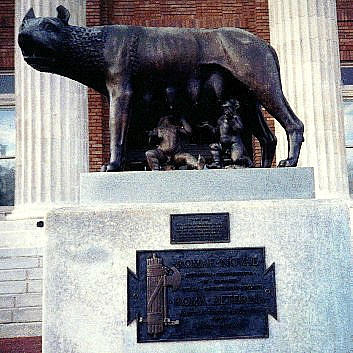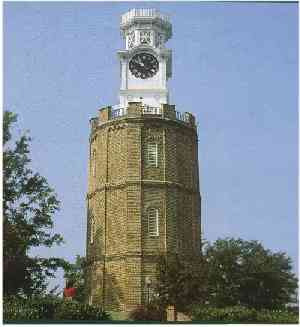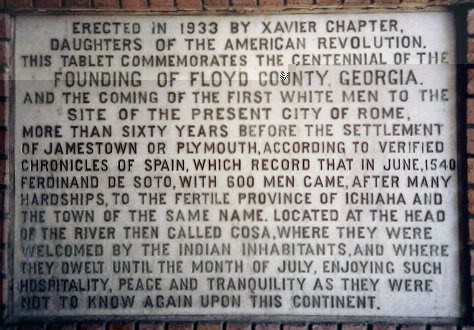


Mention of the Seven Hills of Rome immediately brings to mind images of the ancient city and its geography. A topological survey of the Italian city would present a graphic representation indicating the relative positions and elevations of Palatine Hill (Palatium), Capitoline Hill (Capitolium), Quirinal Hill (Quirinalis), Viminal Hill (Viminalis, Esquiline Hill (Esquiliae), Caelian Hill (Caelius), and Aventine Hill (Aventinus). And rightly so.
A more modest Rome exists, however, and it, too, is situated in and around seven hilly landmarks. Rather than being an Italian city with echoes of Caesar and the famous emperors who followed him, this Rome is located in the southern United States, in Georgia. Located in the foothills of the Appalachian Mountains, it was settled by the Cherokee Indian Tribe, a peaceful tribe that lived in the northwest Georgia area they called their "Enchanted Land" (Vyvyan Lynn, Georgia's Rome)
The Coosa Valley, the dwelling area that had for millennia-from about 1400-been inhabited by the Native Americans, was discovered by Hernando DeSoto in 1540. White settlers began to populate the area and, in 1828, gold was found in Dahlonega, Georgia, a town about 90 miles from Rome. This first American gold rush enhanced the value of the area so much that it culminated ten years later in the removal of the Cherokees by state and federal fiat. The removal, called "The Trail of Tears," has a long and sad history, but that is another story.
Rome was first settled in 1834, where two rivers, the Etowah and the Oostanaula, meet to form the Coosa River, names given by the Native Americans. According to Cherokee tradition, the place where three rivers meet is holy, and Rome sits at the head of the Coosa River. The early Cherokee settlement was named Head of Coosa. A cotton- trading, industrial center with clothing factories and foundries, Rome has become a manufacturing center that includes concrete and crushed stone, transportation and electrical equipment. Like Rome, Italy, Rome, Georgia, was involved in civil war-the war between the northern states (including Western states) and eleven southern states. The southern Confederate town was captured by Union forces in the war, and the Union General William T. Sherman burned the city in November 1864. That, too, is another story, a war story that further suggests a kinship with the other Rome.
Although myth has it that naming the ancient city was the option of Romulus, after he killed Remus, the choice of name for the Georgia town was determined by a drawing. The five founders-Daniel R. Mitchell, Zacharia Hargrove, Philip Hemphill, William Smith, and John Lumpkin, a nephew of the governor of Georgia-had suggestions for the name of the new town. Each wrote his suggestion on a slip of paper which he put into a hat. Quite by chance, the suggestion of "The Seven Hills of Rome" was drawn. Shortened to Rome, the name was suggested by Mitchell, in reference to the ancient city as well as to the local area's hills and rivers. The Georgia Legislature made Rome an official city in 1835. The small area in northwestern Georgia located in the foothills of the Appalachian Mountains evolved in its own geology and mystique.
 The connection to ancient Rome is emphasized by a replica of the famous statue of Romulus and Remus that was a gift in 1929 from Italian dictator Benito Mussolini. When in 1928 an American company began building a rayon plant in Rome as a joint effort with an Italian corporation, Mussolini sent a block of marble from the ancient Roman Forum, inscribed "From Old Rome to New Rome," to be used as the cornerstone of the new rayon plant. The copy of the Capitoline Wolf came the next year and was placed in front of City Hall with a brass plaque inscribed:
The connection to ancient Rome is emphasized by a replica of the famous statue of Romulus and Remus that was a gift in 1929 from Italian dictator Benito Mussolini. When in 1928 an American company began building a rayon plant in Rome as a joint effort with an Italian corporation, Mussolini sent a block of marble from the ancient Roman Forum, inscribed "From Old Rome to New Rome," to be used as the cornerstone of the new rayon plant. The copy of the Capitoline Wolf came the next year and was placed in front of City Hall with a brass plaque inscribed:
ROME NOVAE AUSPICIUM PROSPERITATIS ET GLORIAE LUPAM CAPITOLINAM SIGNUM ROME AETERNA CONSULE BENITO MUSSOLINI MISIT ANNO MCMXXIX
"This statue of the Capitoline Wolf, as a forecast of prosperity and glory, has been sent from Ancient Rome to New Rome during the consulship of Benito Mussolini in the year 1929".
In 1940, when anti-Italian sentiment became very strong due to Italy's entering into World War II, the Rome city commissioners "moved the statue into storage.... In 1952, the statue was restored to its former location in front of City Hall." ( http://www.answers.com/topic/rome-georgia)
Myrtle Hill, located at the junction of the Etowah and Ooostanaula Rivers where the Coosa is formed, towers over the rivers. The hill, with an altitude of 702 feet, had no place name before Rome became a town but was the location of Fort Stovall, a significant Southern citadel against Union forces. Seeking high ground for the occasions when the three rivers flooded the town, Myrtle Hill became the site of a cemetery; it was named for 600 crepe myrtle shrubs planted when the cemetery was opened in 1857 and is on the National Register of Historic Places. Before the late 1930s, when levees were built against the floods, it became the burial place of many Romans, including various city founders and Ellen Axson Wilson, a Rome native and first wife of President Woodrow Wilson.
Mount Aventine is named after ancient Rome's Monte Aventine. The Georgia hill has an altitude of 785 feet, while Monte Aventine's elevation 153 feet. It was developed in 1875, becoming an historic living community. Begun before the formal establishment of the community, it, too, provides an elevated burial place, a Jewish cemetery dating from the early 1800s located at its peak.
Lumpkin Hill also provides another dry location for Romans who are buried in its Oak Hill Cemetery. Although highway construction leveled Lumpkin's peak in 1956, the cemetery was left intact. According to Rome history, the first interments took place in the early 1860s. Some of the dirt removed from the hill during highway construction was used to fortify the levee raised along the Oostanaula.
Blossom Hill, the highest at 785 feet, is unlike the three hills with their cemeteries serving the dead. It provides on-going life for Roman citizens in the form of water. The beautiful aqueducts of Italy's Rome are replaced in the Georgia town by a water treatment plant capable of handling 19 million gallons of water a day from the Oostanaula and Etowah rivers. A folktale from G. M. Battey's A History of Rome and Floyd County addresses the founding of Blossom Hill. He notes that a former slave, Mrs. Mary Shepherd, and her daughter Maggie walked about: "While wandering in search of food, the women were taken in by a judge and his wife." While they lived with the judge's family, Mary and Maggie picked "blossoms from trees on a nearby hill. Mary named it 'Blossom Hill." (Qtd in www.romegeorgia.com/sevenhills.html)
Jackson Hill held Fort Norton from 1863-1864. The fort was "named for Charles B. Norton, "according to Gilbert Smith's "Historical Narrative of Fort Norton/Jackson." Norton was killed at the first battle of Manassas during the Civil War. Entrenchments and earthworks remain from the actions of Confederate soldiers battling the soldiers of the Union. It, too, held a water treatment plant that has ceased to operate.
Old Shorter Hill was the site of what began as the Cherokee Baptist Female College in 1843. The name of the college evolved through Shorter Female College and, finally, to Shorter College. The school eventually moved into the city of Rome, leaving behind only a set of wrought iron gates and a steel stairwell that had led to the school. These artifacts now lead to a residential neighborhood.
 Photo on right: Rome's Tower Clock: "Marking Minutes Since 1872"
Photo on right: Rome's Tower Clock: "Marking Minutes Since 1872"
Clock Tower Hill is Rome's most visible landmark. After the Federal forces had destroyed much of Rome, the town began to rebuild. It found itself in need of a water system. Built in 1872, Rome's first water works system was built on one of the seven elevations that later became known as Clock Tower Hill. When the water works system was moved to Jackson Hill, the 63-foot-tall water tank became the base for the clock's decagon structure. Now a museum, a spiral staircase leads to an observation deck.
"Rome's Historic Clocktower. The 100-foot tower stands atop a grass-covered knoll and is visible from almost any spot within the city's limits. It was built in 1871 as Rome's' water tower. The clock was installed a year later, and though some changes have been made, the massive four-faced timepiece still functions efficiently." http://www.romegeorgia.com)
Not as old, not as storied, but Rome, Georgia, and its seven hills claim kinship to the ancient city of Rome, Italy. Raised up from the wilderness by its native inhabitants, claimed by the new Americans, the city and its seven hills are destinations for many tourists. The city is home to Berry College, founded by Martha Berry whose dream was to build a college for mountain children who could farm for an education. The most expansive campus in the world, Berry has 28,000 acres with hundreds of them devoted to woods and wildlife.
Both Romes recount the history of violent usurpation of the land. Unlike the mythical Romulus' killing of his brother Remus and the subsequent establishment of the Roman legions, the Georgia settlers had the might of federal and state law to force the Native Americans off their land. The earlier Romans moved down from the hills toward the valleys around the Tiber. The later Romans, some of whom were probably descendants of the Roman conquerors in Britain, moved westward to settle into the valleys around the Oostanaula and Etowah, and the head of the Coosa. The two much different cities seem united by more than seven hills. From 750 BCE in Italy to 1838 CE in Georgia, the nature of man's quest for ever-larger domination of the earth seems unchanged. And so it goes.

Joyce Morrow Pair